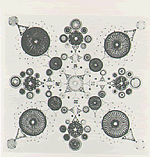The siliceous remains of microscopic diatoms, which are aquatic plants. Also known as
"infusorial earth" and "kieselguhr".
 This
material is a fossil substance, made up of tiny silicon shells left by trillions
of microscopic, one celled algae called diatoms.
This
material is a fossil substance, made up of tiny silicon shells left by trillions
of microscopic, one celled algae called diatoms.
Diatoms first appeared 20 million years ago, but flourished in Mesozoic times (ten million years ago) when
they lived in such enormous numbers they left vast deposits of their shells
up to three thousand feet thick.
Diatoms have one property that sets them apart from other micro organisms. They weave
microscopic shells which they use for the protection and locomotion. These
shells are covered with a pattern of tiny holes so regular that even the
slightest change in their design usually signifies a different species.
As some of the ancient specie died, their shells survived, slowly piling
up in deposits at the bottom of geological lakes and lagoons. When these
lakes dried up, what remained were huge deposits of "diatomaceous earth".
Today there are over 1500 uses for diatomaceous earth, from abrasives, filtering
agents for water and milk, heat insulators for kilns, to polishing agents
in nail polishes and many other applications.
Example of fossilized species




Example of living species



